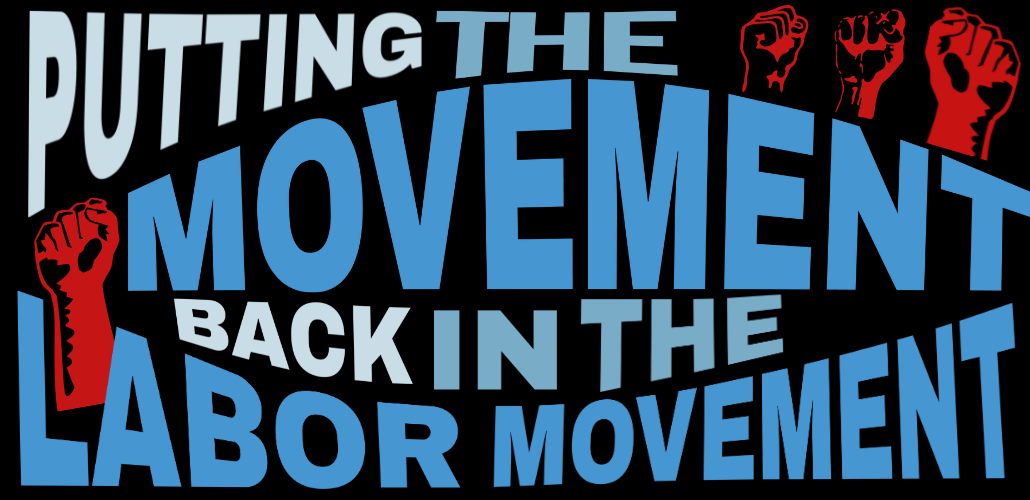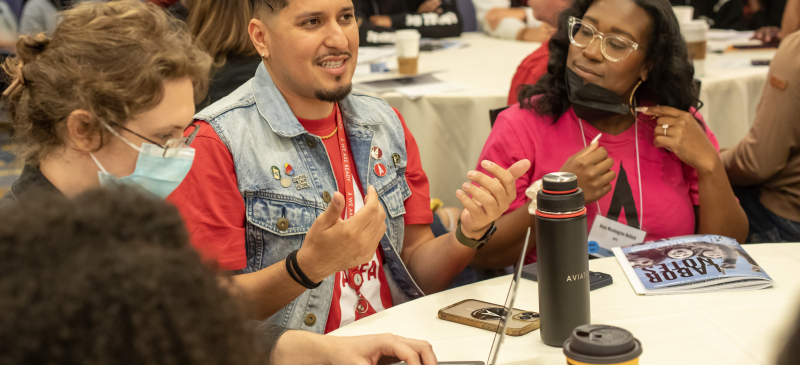
We are in a moment of authoritarian crisis. The attacks are dizzying in their speed and range: Courts are rolling back labor rights. Trump is dismantling the public sector and cracking down on free speech and protest rights. Employers are scrambling to meet his demands. Immigration agents are abducting workers from the streets. All while the very rich get even richer, and working people struggle to make ends meet.
The billionaires behind this assault are using division and fear to keep us isolated and alone. But this moment in history calls for an organized, powerful labor movement acting in solidarity to push back and fight forward for economic and racial justice.
We have work to do. Labor Notes invites you to organize a regional Fightback School to begin this work.
WHAT IS A FIGHTBACK SCHOOL?
These schools will bring rank-and-file workers and community members into conversation to:
- Understand how federal assaults are affecting people in your region
- Name the bosses and billionaires in your region benefiting
- Assess the power you will need to push back against these bosses
- Make plans for actions that build this power within unions and community organizations
Our hope is that these gatherings can become the nucleus for ongoing democratic organizing within each region, to help all of us to win locally and strengthen our muscles to, together, take on the national struggle.
We have developed an agenda outline and some guidelines for pulling together an organizing committee, thinking through who to invite, and knowing when you are ready to launch. The event itself should involve a wide swath of people - including rank and file workers and community members - analyzing power, assessing capacity, and make plans for next steps.

HOW TO ORGANIZE A FIGHTBACK SCHOOL
To start, you'll want to bring together an organizing committee. We recommend starting with members from at least three unions in your area. It's best to have a broad committee, not just members from only one existing activist or political group. The more rank & file union members leading from the start, the more you'll be able to bring in later.
These are questions for the organizing committee to talk about:
- Who should be invited to the Fightback School? Think about unions and workers experiencing a direct impact from the administration’s actions. Think about locals that have leverage. Don’t limit yourself to leadership - reach out to the rank and file.
- What existing structures exist that we should tap into? Did some local unions already participate in May Day Strong actions? Would the local Labor Council help bring in members, not just officers and staff?
- How do we see this school as a first step in building regional, cross-union, member-led fightback? What steps will we want to be prepared to take after the Fightback School, to sustain and grow the movement?
Once you have some ideas about who you will include and what you hope to accomplish, read through this guide to help you plan the logistics of your event.
AGENDA AND ACTIVITIES FOR A FIGHTBACK SCHOOL
These are recommended agenda items and questions for the Fightback School itself. This could be presented simply as questions and not as formally as written.
Brief overview of the purpose of the meeting:
We're here to find a shared understanding on how this administration is hurting working people locally, then assess our power, pick organizing targets, and make initial action plans. We are going to need widespread, collective direct action, both in the workplace and the streets. That's our leverage to grow dissent and undermine the boss allies of this administration. The goal of this meeting is to learn from each other what it takes to get there, and make plans for starting that work.
Groups of three:
Find a group of two other people nearby who you don't know yet. Share your name, union or community group, and one way the administration has negatively impacted you, your family or your coworkers.
Large group discussion: What impacts are we feeling?
- What are the most destructive impacts of the administration we are feeling locally?
- In those spaces feeling those impacts most directly, what kind of organizing response is already happening? Are there communication networks, worker understanding of what is happening, initiation of activity?
Large group discussion: Local bad guys
- Who are the top local billionaires or bosses supporting the administration, or profiting from these attacks?
- For research before or after the meeting, the People's Audit and LittleSis are sites to look up local elites for their campaign donations, corporate and nonprofit board seats.
- Do union workers work locally at any companies of these bad guys?
- Can we pick one or two local billionaires or bosses to target with actions? Which bad guy would be the best lightning rod to rally more attention and support from working people in our area?
Facilitators share: Campaign Mountain
Review the Campaign Mountain from “foundation” to “the height of our power”. In this meeting we are going to assess where we are within our unions along this campaign mountain and where are regionally so that we can plan accordingly. (Could be both contracts and other resistance efforts.)
Breakouts by industry: Assessing our power
- What is the level of awareness within your membership about the actions and impacts of this administration?
- What is your organizational readiness, in terms of member participation in actions and union conversations? What do members already do to flex power?
- What impacts from this administration are most pressing for members/workers?
Large group discussion: Strategy for action
- Where do we have strong organizations ready to take action?
- Where do we need to do more one-to-one conversations and build member organization? (In part 8, sort into breakout groups based on these answers.)
- What are one to two impacts from this administration most widely and deeply shared across our unions and organizations?
- What is the most powerful action we think we could take on this issue?
- Consider a “Reverse Engineering” exercise: Define the desired outcome precisely, and what it would take to win it. See pages 34-37..
- Consider a “Power Analysis Grid” exercise: who has power in your community? Who is represented here today, and who is missing? See pages 111-113.
- What are some low stakes actions to build toward that power and grow solidarity across unions? Have any actions already been taken that we can build on?
Breakouts: Making plans in our unions and organizations
Given the above assessment, do we need to build out the foundation more, or are we ready to plan escalating actions? Break out into groups (ideally about 5-15 people each) by industry and readiness level on either of the following prompts.
Plans for building stronger foundations:
- Do more one-to-one conversations
- Build out communication network within each local
- Identify issues and educate members
- Initiate brief member meetings about the issues and the escalating actions
Plans for escalating actions:
- Identify issues and demands
- Initiate regular brief local meetings about the issue and developing actions
- Series of escalating actions: who, what, when? What can we do in workplaces? What can we do in the streets?
Large group discussion: Next steps
- Where do we see potential for coordination?
- What should be our first coordinated action? Who is the local target? Around what demand?
- Are there workshops or trainings that we should access to support our organizing? Where will locals need more support?
- When should we meet next?

Part Four: Examples and Resources
Here are some examples of workers fighting back that might inspire your group, and add tactics to your toolbox:
- Workplace petitions: Army Corps Workers Defend Parental Leave with Direct Action
- March on the boss: How We Marched on Our Boss (West Virginia)
- Local coalitions: Base Building in the Labor Movement (Spotify or Apple)
- Rallies: Faculty Rally Nationwide for Free Speech, Free Tuition, and to Free Detained Students
- Sit-ins: Washington State Workers Take the Fight to the Governor
- Strike votes: American Airlines flight attendants Strike Vote
- Getting strike ready: Twin Cities Teachers and School Employees Gear up for Strike (2022)
- Going on strike: How to Strike and Win: A Labor Notes Guide
As your group gets specific about who has power in your community or region, you might find you need more information. Who is profiting from rising rents in your area, or from public school closures? Why is it harder to find access to healthcare?
Below are some resources from other organizations that might be useful:
- The People's Audit allows you to search for billionaires by state, and provides a little bit of information about them.
- Little Sis is a research platform for digging into corporate interests in government, universities, employers and more.
- Bargaining for the Common Good. Their website hosts resources on housing and landlords, privatization of public resources, and financialization.
- The Economic Policy Institute keeps up-to-date information on employment, wages, poverty and more.
- Seek out different ways of interpreting the news and public opinion. This might help you find new ways to frame conversations with coworkers or neighbors. Try the Center for Working Class Politics, or Inequality.org.
- Trainings and Resources to Defend Democracy and Build Power. This is a list of several trainings that might be useful for your group.
Local researchers and academics might be willing to help you dig for more dirt on your local target. Are they on the board of a local nonprofit or religious organization? Are other nearby communities also impacted by this bad actor where you can look for more allies?
